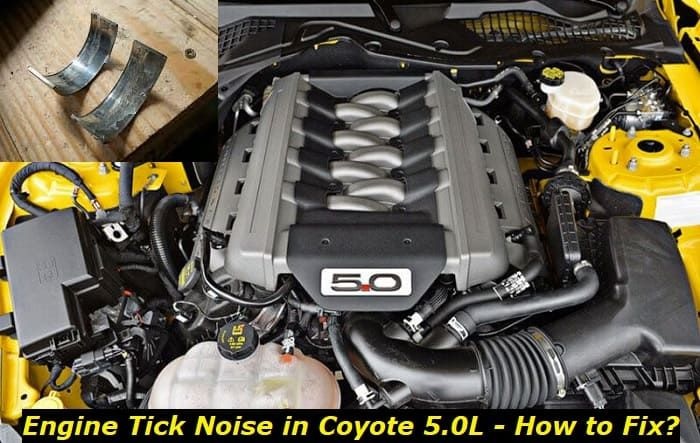Has your 5.0 Coyote engine been making a ticking sound lately? Do not worry - you're not alone! It seems like many Mustang and F150 owners are having this same issue, wondering where the ticking noise is coming from.
Key features and my opinion about the engine
- Production years:2011-now
- Average lifespan of Coyote:280,000-310,000 miles
- Fuel supply type:port injection, later-combined injection (port+direct)
- Power range:360-460 hp
- Fuel efficiency:awful
- Engine block material:aluminum
- Engine reliability score:high
- The most common problems:oil leaks, weak plugs and coils, electronic throttle issues, EGR problems.

5.0 Coyote Engine
The 5.0 Coyote engine, first built by Ford Motor Company in 2011, has made a large impact on the automotive industry. This newer and more efficient version of the engine took its design cues from classic engines of years gone past, like the 429 Cobra.
With a naturally aspirated cubic inch of displacement at five liters and four valves per cylinder, this powerplant delivers superior performance while remaining relatively lightweight, so it can be used for muscle cars, sedans, and even SUVs. The 5.0 Coyote engine can be found in Ford Mustangs and F-150s.
There are three generations of 5.0 Coyote engines. The first generation was released in 2011-2014. The second generation was used in 2015-2017 models, while the third generation has been in Ford Mustangs since 2018. With each generation of the 5.0 Coyote engine, Ford has improved the performance and internals to allow for more power and an overall more refined engine experience.
For example, since 2011, the Mustang GT with the 5.0 Coyote engine has gone from 412 horsepower to 460 horsepower in 2018.
Innovative 5.0 Coyote features like dual direct-belt-driven cams provide an efficient and reliable engine speed boost for those who need more power. What's more, with its decent fuel economy compared to similar high-performance models, the 5.0 Coyote engine is becoming a favorite among many car enthusiasts looking to maximize their driving experience without compromising on efficiency.
What Causes the Tick
The 5.0 Coyote engine brings plenty of power and performance to vehicles, but some owners may notice an odd ticking noise coming from the engine compartment. Some people describe it as a "barbecue tick" or a "typewriter tick." It is quite a noticeable sound, more like a tinny noise, but it does not sound like a piston slab, which might be an indication of an engine failure.
Most people get it after their first oil change, and it can stay there for a long time, which is definitely something you don't want to hear after you've bought a brand-new car.
Actually, Ford doesn't say anything about possible reasons for the ticking noise in the 5.0L Coyote engine. But we will say!
Here are the reasons:
1) Low oil level or poor oil quality
Ticking noise may come from valves and this means that the valves or lifters don't get lubricated properly. This is almost always connected with the low oil level or too viscose oil. Never experiment with the oil quality and avoid using any lubricant that is very different from the recommended properties.
Also, watch the oil level. The 5.0L Coyote engine is very often leaking oil and this may lead to low levels of the lubricant. The low oil pressure that comes from low levels will destroy the engine quickly. And the ticking noise is only the beginning, in this situation.
2) Exhaust leak
It's hard to describe how exactly the exhaust leak makes a ticking noise, but this is a common problem with the 5.0L Coyote engine. Check for exhaust lick whenever you get the ticking noise. Unfortunately, it's quite hard to locate this problem on your own, so we recommend you go to the dealership or a good repair shop that knows how Ford engines work.
3) Misfiring because of ignition system issues
You should check the spark plugs and the coils. Spark plugs very often get fouled prematurely and require replacement. This may lead to coil burning and also to engine misfiring. Interestingly, the Coyote engine may not throw a code that would tell you about misfires.
So, the ticking noise may actually be the knocking of the engine because one of the cylinders misfires and causes fuel to come to the exhaust system and explode there. This is why the noise may be so inconsistent.
How to Diagnose the Tick
We wouldn't say that it's impossible to diagnose the tick in the Coyote engine. But for this, you need to have some experience and understanding of how the engine works.
Here's what you can do:
1) Use the OBD2 scanner
With the help of the OBD2 scanner, you may easily check if the engine is misfiring, for example. The P0300 code (or P0301, P0302, etc.) will tell you that there is a problem with ignition and you will be able to check the coils and spark plugs attentively.
2) Check the oil levels
This is probably the easiest way to check the reason for the 5.0L Ford engine to make a ticking noise. If the level is at the MIN mark or even lower than that, immediately top up some oil. The optimal level for these engines is between the MAX mark and the middle of the measure gap. Keep it closer to the MAX mark to get some extra protection.
These engines love burning some oil and you will want to have the maximum possible level in your engine so that if it burns half a liter for your long trip, you still have enough oil to lubricate all the necessary parts.
3) Locate the tick sound
If the ticking sound is still there when the engine idles, try to locate the spot where the sound comes from. Maybe, this is the timing system and you need to check the timing chain and the tensioner. Or maybe one of the pulleys of the drive belt (alternator belt) is malfunctioning.
Anyway, when you know the place that the ticking sound comes from, it's much easier to locate and solve the problem.
4) Have the engine inspected
Please don't waste your time! If the ticking noise is annoying, it may mean that there is a serious problem with the valve system or the ignition in your engine. Maybe, if you go to the dealership right now, they will find and solve the issue and save the engine. If you keep driving with this problem progressing, your Coyote is at risk of getting a fatal problem and requiring replacement.
Top 6 Fixes for the 5.0 Coyote Engine Tick
Need to fix your 5.0 Coyote engine tick? Whether you're a die-hard Mustang fan or just looking for some muscle car performance, sorting out this issue can be critical because that tick can be very annoying. Unfortunately, there aren't any official solutions for this problem, but you can try using the following tips:
1) Change oil
Even if the oil is not yet old or contaminated, change it. We saw situations when Coyote owners went to independent shops and had problems with the viscosity and quality of oil. They were told that the original Ford recommended oil was used during engine maintenance but mechanics actually used some other inappropriate oil.
So, if you hear the engine tick in your Coyote soon after changing the oil, just change the oil and filter once more. Do it in the dealership or in the trusted repair shop to avoid the same problem.
The quality and viscosity of oil is extremely important. Sometimes, we see tips on the internet to use thicker oil to avoid ticking in the engine. But this is ridiculous! You may kill your 5.0L engine and just need to overhaul it or even buy a new one!
2) Check the ignition coils
It's important to make sure that the ignition coils in your Coyote engine work well. Checking them is not that easy. You may start with a scanner and find the code. If it says P0303, for example, you will know that the misfiring occurs in the third cylinder. Swap the ignition coils between the third and the fourth cylinder and see if the code changed to P0304. If it did, you may be sure that the coil that is currently in the fourth cylinder needs replacement.
There are professional ways to check the coils but you will need to pay for them. If you have a certain misfiring code in the ECU right now, swapping the coils is a pretty precise and free-of-charge method you can use.
3) Check your spark plugs
If you have a 5.0 Coyote engine, chances are you've identified the dreaded ticking. But before you start to worry, know that checking your spark plugs may be the solution. As a simple and easy fix, ensuring your spark plugs are gapped correctly and in good condition can save you tons of hassle with very little effort required.
The plugs can also be checked the way the ignition coils were checked in the previous step. If you have the misfiring code, swap the plugs between the cylinders and see if the code changes. Spark plugs should be changed in these engines about once every 30K miles. They tend to get covered in oil buildup and lose their efficiency.
4) Replace the leaking part of the exhaust system
You can also find out that the ticking noise in your engine comes from exhaust problems. If it's so, just buy the needed exhaust part and replace the old leaking element with the new one. It may cost you quite a lot because OEM exhaust parts for the 5.0L Coyote engine are priced extremely high. But still, if you have an exhaust leak, there is just no way you can deal with it.
Exhaust manifolds, pipes, catalytic converters, and also connections may be the issues. Sometimes, welding in the exhaust shop may save you a couple of months. But, as a rule, this is not a very long-term solution. Still, you can try to weld the problematic spot and see if it helps with the ticking noise.
5) Check if you use high-grade fuel
This engine is made of good high-octane fuel. If you are using crappy fuel with low octane numbers, there is no way for you to avoid ticking noise. The unburnt fuel will explode somewhere in the engine or in the exhaust system and will slowly destroy the engine.
It's not a good idea to buy low-grade fuel for your F-150 or Mustang powered by the Coyote engine. The engine is almost a piece of art and is made for high performance. But with the wrong type of fuel, it will turn out to be a disaster in terms of driving and maintenance.
6) Incorporate periodic cleaning of your fuel injectors
You may also want to consider incorporating periodic cleaning of your fuel injectors into your regular car maintenance routine. There is no magic fix, and it's always best to be proactive when it comes to car care, but the expert consensus seems to say that a thorough scrubbing up of the fuel injectors can help get the volume turned down on that noisy tick.
Regular fuel injector cleaning should keep your engine humming along smoothly on rides both short and long, giving you complete peace of mind while you speed into the sunset.
So don't put away the tools and leave it at that - make sure you address these six key fixes and keep your 5.0 Coyote engine in optimal condition.
Conclusion
The 5.0 Coyote engine has been known to have a tick problem for some time now. In this blog post, we've discussed the causes of the ticking sound and potential solutions, which include the use of heavier oils, friction modifiers, and appropriate fuels.
Have you experienced this issue with your car? If so, what solution did you end up using? Let us know in the comments below.
About the authors
The CarAraC research team is composed of seasoned auto mechanics and automotive industry professionals, including individuals with advanced degrees and certifications in their field. Our team members boast prestigious credentials, reflecting their extensive knowledge and skills. These qualifications include: IMI: Institute of the Motor Industry, ASE-Certified Master Automobile Technicians; Coventry University, Graduate of MA in Automotive Journalism; Politecnico di Torino, Italy, MS Automotive Engineering; Ss. Cyril and Methodius University in Skopje, Mechanical University in Skopje; TOC Automotive College; DHA Suffa University, Department of Mechanical Engineering






Add comment